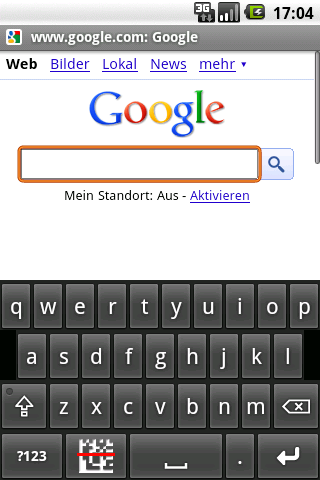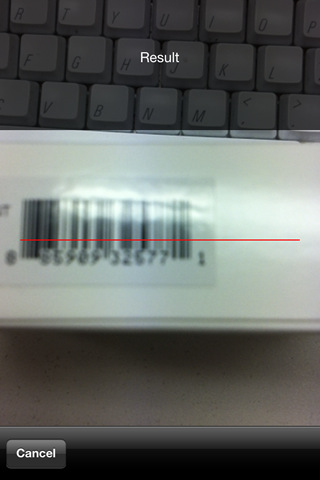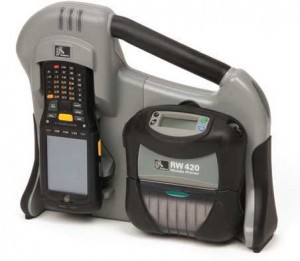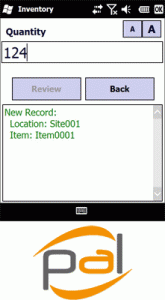Barcode Keyboard for Android Lets You Scan Wherever You Can Type

Barcode Keyboard app from TEC-IT replaces the standard on-screen keyboard on your Android device with one that includes a barcode key. Clicking the barcode key uses your phone’s camera to make snap a picture of a barcode and then automatically enters the decoded contents of the barcode wherever the cursor is located.
The Barcode Keyboard software also supports advanced setting like data prefixes and suffixes (characters that are automatically entered before or after the scanned barcode).
This software helps convert your Android phone into a very basic barcode scanner.
AirScan Wireless Barcode Inventory Scanner for iPhone

lividbox.com has just released AirScan for iOS devices with auto-focus cameras (iPhone 3GS, iPhone 4, and 4th generation iPod touch).
In contrast to the many “barcode scanner” apps in the App Store that are designed only for price checking, AirScan allows you to use your iPhone/iPod as a wireless barcode scanner. Barcodes scanned with the software are sent wirelessly to a computer “base station” (running a special, free, iBarcode server). Barcodes can also be saved to the clipboard on your iPhone.
Zebra RW 420 Route Palette integrates Motorola’s MC9500 Series Mobile Computers
 Zebra announces the release of their next version of rugged RW 420 Route Palette. This integrated carrying device is designed to work specifically with Motorola’s new MC9500 industrial grade mobile handheld computer. Ideal for route accounting, direct store delivery or field service and sales operations, the RW 420 brings efficiency and ease-of-use to field mobility applications, saving valuable time and money.
Zebra announces the release of their next version of rugged RW 420 Route Palette. This integrated carrying device is designed to work specifically with Motorola’s new MC9500 industrial grade mobile handheld computer. Ideal for route accounting, direct store delivery or field service and sales operations, the RW 420 brings efficiency and ease-of-use to field mobility applications, saving valuable time and money.
Designed to handle the harsh demands of mobile computing in the field, the RW 420 Route Palette is the most rugged of its kind, with an Ingress Protection (IP) rating of IP 42, making it resistant to certain environmental conditions, such as moisture, dust and dirt.
Free Inventory, Asset Tracking, Data Collection and Order Entry Apps for Datalogic Windows Mobile Computers
 Datalogic has just introduced “Pal”, a free suite of simple data collection apps for all Windows CE & Windows Mobile based Datalogic handheld computers.
Datalogic has just introduced “Pal”, a free suite of simple data collection apps for all Windows CE & Windows Mobile based Datalogic handheld computers.
Pal apps are compatible with Memor, Elf, Falcon 4400 series, Pegaso, J Series, Kyman and Skorpio mobile computers.
Right out of the box, Pal makes it easy to collect data, transfer it, view on your mobile computer, and load it into an Excel spreadsheet.
The Pal suite of apps includes:
- Shelf Inventory – Perfect for performing a physical inventory or cycle counting in your store or warehouse. Data collected includes location, SKU and quantity.
- Asset Tracking – Quickly and easily take an asset inventory. Data collected includes location and asset.
- Shelf Replenishment – Instantly generate a pick list to replenish low shelf stock. Data collected includes store, shelf ID, SKU and quantity.
- Order Entry – Place an order in the field to replenish stock. Data collected includes site, order id, SKU and quantity.
- Communicator – Pal Communicator is a PC application that allows the transfer of data on demand or automatically between your PC and a Datalogic handheld. This utility also provides features data viewing in Excel, or Notepad.
The apps are ready to use, but can also be configured to meet your specific needs.
Download free Pal data collection apps for Datalogic mobile computers
Delivering Efficiency: Streamlining Pick-Up and Delivery in the Post & Parcel Industry
Introduction
In today’s fast-paced post and parcel industry, streamlined efficiency is more important than ever. Often times, however, the determining factors are out of our control.
Many of the most technologically-advanced delivery companies in the world still pick up a relatively high percentage of their items without prior knowledge of the destination or any other delivery element prior to taking physical control of the item.
When challenged, some of the most advanced companies in the world found “surprises” like these are accounting for as much as 10-25 percent of the items they are picking up. That is as much as 25 percent of their business they don’t know about in advance – meaning they can’t plan for downstream processes, in turn eliminating much (if any) chance to do dynamic network optimization or downstream labor planning. That also means as much as 25 percent of their business also requires someone to sit in front of a computer to manually enter the shipping details, including the delivery address, which they tell us can take in excess of one minute per package – ultimately costing millions of dollars each year. If they want any chance of advanced notice on the shipment and true tracking from the point of pickup, it entails having their most expensive resource, the courier, enter the data on their mobile computer. Our customers have found that these methods are not only time consuming, but very error prone as well.
And, due to decreasing work forces and overall increased productivity issues, delays and other shipping errors are further decreasing customer satisfaction. According to a 2009 Gallup Poll, the U.S. postal industry alone has lost $8 billion since 2007. In order to be successful in such challenging times, industry leaders must find ways to both increase revenue and reduce costs. To mitigate these issues, post and parcel industry operators are actively pursuing new technologies to help enhance profitability, while also increasing visibility and planning capabilities through the elimination of errors. New technology solutions may hold the key to solving this issue.
Improving Store Systems Efficiency Through the Use of Mobile Devices
The use of mobile devices has long been commonplace in retail stores across the globe. A recent survey by AMR Research/Gartner concluded that mobile store technologies will cover 72% of all retail locations during this year. Most significantly, the report added that the average number of mobile devices per store will grow from 4 to 16. In the UK, very few of the leading 200 retailers do not use any form of mobile device in their stores.
The benefits of using such devices in store have become simply far too compelling for retailers not to invest. The efficiency improvements and costs savings always result in an extremely rapid Return on Investment (ROI). Coupled with the need to offer an improved customer shopping experience to stay head of the competition, the arguments for investing in mobile technology are quite overwhelming.
The purpose of this White Paper is to explore the main drivers for this explosion of mobile technology and to provide a summary outline of the primary benefits from the retailers’ perspective.
Background
In a fiercely competitive landscape, retailers have been long driven to make every penny count, in a never ending quest to reduce costs and increase margins. Whatever the store environment, the same challenge persists, namely to maintain and manage stock to the optimum level. Since the introduction of commercial bar coding in the 1970s, retail items have long carried a globally unique number to track each item at either consumer or traded unit level. The first deployment of item tracking came in the form of installing scanners to read bar codes at the Point of Sale. This produced immediate productivity and efficiency gains by dramatically speeding up the checkout process, substantially reducing errors and providing an accurate picture of inventory.
These same speed and accuracy benefits apply when bar code scanning is integrated within a mobile device. Quickly after the first wave of the introduction of POS scanners, the benefits of item tracking were translated to track goods-in movements, perpetual inventory and replenishment by installing mobile devices with built in bar code scanners.
Handheld barcode scanner mobile computers started to appear in the retail store environment as early as the 1970s. Most retailers in the UK are now on their second, third or even fourth generation of mobile devices. The Handheld barcode scanner mobile computer is regarded as a mission critical tool which occupies a place at the heart of most progressive retailers’ store systems’ strategy.
Improve Patient Safety with a Quality Wristband Solution

How Printer Choice and Other Variables Impact Wristband Quality, Positive Patient Identification and Medical Errors
The foundation for patient safety is positive patient identification, which begins with the wristband. Poor quality wristbands can lead to patient misidentification and medical errors. Poor quality wristbands can also prevent organizations from leveraging processes and tools for enhancing patient safety, including automated Five Rights checks, bar code point-of-care (BPOC) systems and electronic medical administration records (eMAR). By improving wristband quality, and improving the convenience of how wristbands are produced, healthcare organizations can improve the accuracy, efficiency and quality of patient care.
A wristband’s ability to enhance quality of care depends on the quality of the wristband itself. Unfortunately, wristband quality varies widely and cannot be taken for granted. Incidents of wristbands falling off or becoming illegible are not uncommon. Consequently, transcription errors and patient misidentification aren’t uncommon either. Wristband print quality will become even more important as bar coding becomes more prevalent in healthcare.
Wristband quality and consistency depend heavily on the print technology, printer model and wristband material used. This white paper highlights how these variables impact wristband quality, documents the links between wristbands, positive patient identification and patient safety, and provides guidance for wristband solutions that deliver accuracy, safety and convenience throughout the patient care path.
Why Wristband Quality Matters to Patient Safety
Wristband quality directly affects accuracy in patient identification. Patient misidentification was the root cause of 72 percent of adverse events according to a U.S. Veterans Administration (VA) Health System study.
A UK study found that missing wristbands and wristbands with incorrect information were directly responsible for 236 incidents and near misses in a 19-month period.
Numerous patient safety studies, organizations and government agencies have called for improving positive patient identification processes, often citing the benefits of bar code-based automated wristband checks. Despite some progress in this area and increased use of bar code medication administration, electronic medical records and other automated safeguards, there is still substantial room for improvement. In recognition of this need, the Joint Commission (JCAHO) made its top National Patient Safety Goal (NPSG) for 2010: Improve the accuracy of patient identification. It has been the number- one goal every year since the NPSG program began in 2002.
The implications of patient misidentification are clear. For example:
- Medication errors harm more than 1.5 million people in the U.S. each year
- Hospitals alone spend an estimated $3.5 billion annually treating erroneous drug-related injuries contributing to unnecessary care costs
- There were 116 wrong-site surgeries, including surgery on the wrong patient, reported to the Joint Commission in 2008 (the last year for which data is available), making wrong-site surgery the most-reported sentinel event in 2008
Two thirds of blood transfusion errors are associated with incorrect recipient identification at the patient bedside.
There are several common wristband problems that contribute to patient identification errors. Leading problems include wristbands that are missing, damaged or contain illegible information. Sometimes wristbands are smudged or fade from the time they are printed. If bar codes are used, slight imperfections like these can easily make the symbols unreadable. Wristbands with no initial quality problems may become unreadable or fall off after several days of wear and exposure to common things like water, soap, alcohol and other sanitizers. Many of these quality problems and their causes are not readily apparent, but the medical error data previously referenced clearly shows some of the risks of poor wristband quality.
CipherLab 1704 Rugged 2D Barcode Scanner Ready For Any Environment
With IP54-sealed rugged design, audio/visual/tactile scan confirmation, high-resolution 2D capabilities and 1.3 megapixel imaging, the CipherLab 1704 is ready for the future.
CipherLab, adds a new dimension to its leading range of rugged mobile computers and barcode scanners with a feature- packed new 2D device. The CipherLab 1704 offers 1D/2D functionality and 1.3 megapixel imaging capabilities in a single, affordable package that can cope with everything from 3 mil barcodes to signatures, and optionally even full A4 documents. Another standout feature of the 1704 is its innovative scan confirmation system, which includes variable volume level, LED and vibrator. CipherLab’s trademark rugged design and the sheer versatility of the 1704’s feature set reduce the total cost of ownership, making it a great long-term investment in employee productivity.
New Software Allows Bluetooth Barcode Scanners to connect to Android Devices
Software developers can now add commercial-grade barcode scanning capabilities to Android applications
Socket Mobile announced the availability of SocketScan 10 beta for Google Android. SocketScan 10 is a highly versatile barcode scanning software tool that enables developers to add commercial-grade rapid and robust barcode scanning capabilities to their smartphone, tablet, notebook and desktop applications. Compatible products for the beta Android release include all v3 models of the Socket Bluetooth® Cordless Hand Scanner™ (CHS) Series 7 portable 2D and 1D barcode scanner.
Datamax 4te Printer and Qualcomm OmniTRACS Mobile Information System Refine Crude Oil Transportation
 Every day, millions of people drive into gas stations to refuel their cars without giving a thought to the process of how that fuel gets there when they need it. Genesis Crude Oil plays a central role in transporting fuel to gas stations in the Gulf Coast region of the Unites States, which encompasses the states of Texas, Louisiana, Arkansas, Mississippi, Alabama, and Florida.
Every day, millions of people drive into gas stations to refuel their cars without giving a thought to the process of how that fuel gets there when they need it. Genesis Crude Oil plays a central role in transporting fuel to gas stations in the Gulf Coast region of the Unites States, which encompasses the states of Texas, Louisiana, Arkansas, Mississippi, Alabama, and Florida.
Genesis Crude Oil is a division of Houston-based Genesis Energy, a growth-oriented company with a diverse portfolio of customers, operations, and assets, including refinery-related plants, pipelines, storage tanks, and terminals The primary function of Genesis Crude Oil is moving crude oil, via trucks, from pumping stations to strategically located storage facilities, where the product is held until it’s time to move it to a refinery.
To make sure its deliveries always flow smoothly, Genesis Crude Oil equipped its fleet of trucks with the OmniTRACS® Mobile Information System from Qualcomm Enterprise Services. This system allows Genesis dispatchers to maintain contact with all drivers at all times. “We can use the OmniTRACS® System to send messages to drivers in places that cell phones don’t reach,” says Terry Lincecum, Louisiana district manager for Genesis Crude Oil.
The system, which relies on satellite technology, also sends data about conditions on the truck—such as its current location or the temperature and weight of the product being carried—back to regional headquarters. “If there’s a problem with one of our trucks after it leaves the pick-up location, we can find out about it before the driver reports it,” Lincecum says. That’s an important capability, because drivers are picking up crude oil from pumping stations in remote areas, and having to wait for drivers to be in cell phone range to learn about problems could delay finding solutions.
Problem
About a year ago, as the Louisiana region was adding new trucks to its fleet, Lincecum discovered a way to make the OmniTRACS® System even more valuable: he upgraded the printers they use with the system. Genesis Crude Oil drivers rely on wireless mobile printers to generate receipts confirming the contents of the loads they pick up from each customer. The driver also keeps a copy of the receipt to use as a manifest if a Department of Transportation inspector asks for documentation of the truck’s contents.
The information on that receipt also is transmitted, via the OmniTRACS® System, to Genesis Crude Oil headquarters, facilitating accurate recordkeeping. “As we were adding the new trucks, we realized that the printers we were using were becoming obsolete,” Lincecum recalls. One clue to this obsolescence was the increased frequency with which those printers were being repaired. After reviewing the costs of those ongoing repairs, Lincecum thought it was time to consider replacing them.
Solution
Genesis Crude Oil selected the Datamax microFlash 4te wireless portable thermal transfer printer. The 4te is the latest version of Datamax-O’Neil’s legendary 4t printer, the industry’s leading portable thermal printer and the defacto standard for route accounting and field mobile printing applications.
To accommodate the need for faster transaction processing in the fast-paced world of mobile field applications, the 4te printer incorporates a new, 32-bit RISC ARM 9 processor that allows the printer to process complex applications up to ten times faster, and enables the user to enjoy exceptionally high print throughput. It can print up to 2,240, 6-inch receipts on a single battery charge with automated, power-saving sleep and wake-up modes.
That printing capability was a selling point for Genesis Crude Oil, which was getting complaints from drivers about having to replace the paper in the older printers too often. But the most attractive feature of the 4te, according to Lincecum, was the newly developed kit for pairing the printer with the Qualcomm OmniTRACS® System. The kit made the transition to the new printer seamless. “Our drivers and customers really like these new printers,” Lincecum says. “The drivers like them because they don’t have to change the paper as often; that improves their efficiency. Customers like them because the print quality is much better. The receipts are much easier to read.”
Results
Lincecum says Genesis Crude Oil is pleased that the 4te is continuing the Datamax-O’Neil tradition for product reliability. After six years in the field, fewer than 10 percent of the units have ever been in a repair facility, even though they operate in harsh industrial environments.
“We don’t have nearly as much downtime now,” Lincecum says. “With our previous printers, when one went down, the driver would have to locate another truck nearby and wait for that driver to show up to print a receipt for the customer. We haven’t had those issues with the Datamax-O’Neil printers.”




